Energy Characteristics of Full Tubular Pump Device with Different Backflow Clearances Based on Entropy Production
Abstract
1. Introduction
2. Numerical Simulation Method
2.1. Three-Dimensional Geometry Model
2.2. Mesh Generation
2.3. Conservation Equations and Boundary Conditions
2.4. Entropy Production Theory
2.5. Validation of Numerical Simulation
3. Analysis of Calculation Results
3.1. Comparison of Pump Performance
3.2. Comparison of Total Dissipation under Different Backflow Clearances
3.3. Comparison of Inner Flow Field
4. Conclusions
Author Contributions
Funding
Institutional Review Board Statement
Informed Consent Statement
Data Availability Statement
Conflicts of Interest
Nomenclature
| (mm) | Backflow clearance radius |
| (m/s) | Time-averaged velocity |
| (m/s) | Velocity component in the x direction of Cartesian coordinates |
| (m/s) | Velocity component in the y direction of Cartesian coordinates |
| (m/s) | Velocity component in the z direction of Cartesian coordinates |
| [J/(K·kg)] | Specific entropy |
| (W/m2) | Heat flux density vector |
| (W/m3) | Viscous dissipation rate |
| (W·K/m3) | Entropy production term |
| [J/(K·kg)] | Time-averaged specific entropy |
| (kg/m3) | Density of liquid |
| (K) | Temperature |
| (W/m3) | Direct dissipation rate |
| (W/m3) | Indirect dissipation rate |
| (W/m3) | Total dissipation rate |
| (W) | Power dissipation caused by direct dissipation rate |
| (W) | Power dissipation caused by indirect dissipation rate |
| (W) | Total power dissipation |
| (m3/s) | Volume flow rate |
| (Pa) | Total pressure of outlet |
| (Pa) | Total pressure of inlet |
| (W) | Shaft power |
| (m3/s) | Design flow rate |
| (m3/s) | Volume flow rate in back flow clearance |
| (m) | Head of full tubular pump device |
| (%) | Efficiency of full tubular pump device |
| (W/kg) | Dissipation rate of turbulent kinetic energy |
| (mm) | Radius of the cylinder section |
| (mm) | Radius of the impeller hub |
| (mm) | Radius of the impeller rim |
Abbreviations
| 3D | Three-Dimensional |
| CBV | Clearance backflow vortex |
| BTC | Blade tip clearance |
| TLV | Tip leakage vortex |
| SST | Shear stress transport |
| URANS | Unsteady Reynolds-Averaged Navier-Stokes equation |
| CFD | Computational Fluid Dynamics |
| EXP | Experiment |
References
- Wang, W.; Wang, W.; Zhang, l.; Zhao, L.; Lu, J.; Feng, J.; Luo, X. Mechanism for end-wall slots to improve hump in an axial flow pump. Trans. Chin. Soc. Agric. Eng. 2020, 36, 12–20. (In Chinese) [Google Scholar]
- Xi, S.; Desheng, Z.; Bin, X.; Weidong, S.; van Esch, B. Experimental and numerical investigation on the effect of tip leakage vortex induced cavitating flow on pressure fluctuation in an axial flow pump. Renew. Energy 2021, 163, 1195–1209. [Google Scholar] [CrossRef]
- Shi, L.; Jiao, H.; Gou, J.; Yuan, Y.; Tang, F.; Yang, F. Influence of backflow gap size on hydraulic performance of full-flow pump. Trans. Chin. Soc. Agric. Mach. 2020, 51, 139–146. (In Chinese) [Google Scholar]
- Shi, L.; Zhang, W.; Jiao, H.; Tang, F.; Wang, L.; Sun, D.; Shi, W. Numerical simulation and experimental study on the comparison of the hydraulic characteristics of an axial-flow pump and a full tubular pump. Renew. Energy 2020, 152, 1455–1464. [Google Scholar] [CrossRef]
- Shi, L.; Yuan, Y.; Jiao, H.; Tang, F.; Cheng, L.; Yan, J.; Yan, J.; Zhu, J. Numerical investigation and experiment on pressure pulsation characteristics in a full tubular pump. Renew. Energy 2021, 163, 987–1000. [Google Scholar] [CrossRef]
- Xu, B.; Shen, X.; Zhang, D.; Zhang, W. Experimental and numerical investigation on the tip leakage vortex cavitation in an axial flow pump with different tip clearances. Processes 2019, 7, 935. [Google Scholar] [CrossRef]
- Zhang, D.; Shi, W.; Esch, B.; Shi, L.; Dubuisson, M. Numerical and experimental investigation of tip leakage vortex trajectory and dynamics in an axial flow pump. Comput. Fluids 2015, 112, 61–71. [Google Scholar] [CrossRef]
- Hao, B.; Cao, S.; He, C.; Li, L. Experimental study of the effect of blade tip clearance and blade angle error on the performance of mixed-flow pump. Sci. China 2013, 56, 293–298. [Google Scholar]
- Yu, H.; Zhang, Z.; Hua, H. Numerical investigation of tip clearance effects on propulsion performance and pressure fluctuation of a pump-jet propulsor. Ocean Eng. 2019, 192, 106500. [Google Scholar] [CrossRef]
- Wang, C.; Weng, K.; Guo, C.; Gu, L. Prediction of hydrodynamic performance of pump propeller considering the effect of tip vortex. J. Ocean Eng. 2019, 171, 259–272. [Google Scholar] [CrossRef]
- Shi, G.; Liu, Z.; Xiao, Y.; Li, H.; Liu, X. Velocity characteristics in a multiphase pump under different tip clearances. Proc. Inst. Mech. Eng. Part A J. Power Energy 2020. [Google Scholar] [CrossRef]
- Liu, Y.; Han, Y.; Tan, L.; Wang, Y. Blade rotation angle on energy performance and tip leakage vortex in a mixed flow pump as turbine at pump mode. Energy 2020, 206, 118084. [Google Scholar] [CrossRef]
- Zhang, D.; Shi, W.; Pan, D.; Dubuisson, M. Numerical and experimental investigation of tip leakage vortex cavitation patterns and mechanisms in an axial flow pump. J. Fluid Eng. 2015, 137, 121103. [Google Scholar] [CrossRef]
- Shen, X.; Zhang, D.; Xu, B.; Jin, Y.; Shi, W.; Esch, B. Experimental investigation of the transient patterns and pressure evolution of tip leakage vortex and induced-vortices cavitation in an axial flow pump. J. Fluid Eng. 2020, 142, 101206. [Google Scholar]
- Liu, Y.; Tan, Y.; Yue Hao, Y.; Xu, Y. Energy performance and flow patterns of a mixed-flow pump with different tip clearance sizes. Energies 2017, 10, 191. [Google Scholar] [CrossRef]
- Huang, Z.; Han, Y.; Tan, L.; Huang, C. Influence of t-shape tip clearance on energy performance and broadband noise for a naca0009 hydrofoil. Energies 2019, 12, 4066. [Google Scholar] [CrossRef]
- Shi, L.; Zhang, D.; Zhao, R.; Shi, W.; Jin, Y. Effect of blade tip geometry on tip leakage vortex dynamics and cavitation pattern in axial-flow pump. Sci. China Technol. Sci. 2017, 60, 1480–1493. [Google Scholar] [CrossRef]
- Fabian, K.; Heinz, H. Local entropy production in turbulent shear flows: A high-Reynolds number model with wall functions. Int. J. Heat Mass Transf. 2004, 47, 2205–2215. [Google Scholar]
- Fabian, K.; Heinz, H. Entropy production calculation for turbulent shear flows and their implementation in cfd codes. Int. J. Heat Fluid Flow 2005, 26, 672–680. [Google Scholar]
- Gong, R.; Wang, H.; Chen, L.; Li, D.; Zhang, H.; Wei, X. Application of entropy production theory to hydro-turbine hydraulic analysis. Sci. China 2013, 56, 1636–1643. [Google Scholar] [CrossRef]
- Cui, B.; Li, J.; Zhang, C.; Zhang, Y. Analysis of radial force and vibration energy in a centrifugal pump. Math. Probl. Eng. 2020, 2020, 6080942. [Google Scholar] [CrossRef]
- Jia, X.Q.; Zhu, Z.C.; Yu, X.L.; Zhang, Y.L. Internal unsteady flow characteristics of centrifugal pump based on entropy generation rate and vibration energy. Proc. Inst. Mech. Eng. Part E J. Process Mech. Eng. 2019, 233, 456–473. [Google Scholar] [CrossRef]
- Li, Y.; Zheng, Y.; Meng, F.; Osman, M. The effect of root clearance on mechanical energy dissipation for axial flow pump device based on entropy production. Processes 2020, 8, 1506. [Google Scholar] [CrossRef]
- Chang, H.; Shi, W.; Li, W.; Liu, J. Energy loss analysis of novel self-priming pump based on the entropy production theory. J. Therm. Sci. 2018, 28, 306–318. [Google Scholar] [CrossRef]
- Zhang, F.; Appiah, D.; Hong, F.; Zhang, J.; Yuan, S.; Adu-Poku, K.A.; Wei, X. Energy loss evaluation in a side channel pump under different wrapping angles using entropy production method. Int. Commun. Heat Mass 2020, 113, 104526. [Google Scholar] [CrossRef]
- Yang, B.; Li, B.; Chen, H.; Liu, Z. Entropy production analysis for the clocking effect between inducer and impeller in a high-speed centrifugal pump. Proc. Inst. Mech. Eng. Part E J. Process Mech. Eng. 2019, 233, 5302–5315. [Google Scholar] [CrossRef]
- Hou, H.; Zhang, Y.; Zhou, X.; Zuo, Z.; Chen, H. Optimal hydraulic design of an ultra-low specific speed centrifugal pump based on the local entropy production theory. Proc. Inst. Mech. Eng. Part A J. Power Energy 2019, 233, 715–726. [Google Scholar] [CrossRef]
- Ji, L.; Li, W.; Shi, W.; Chang, H. Energy characteristics of mixed-flow pump under different tip clearances based on entropy production analysis. Energy 2020, 199, 117447c. [Google Scholar] [CrossRef]
- Shen, S.; Qian, Z.; Ji, B. Numerical Analysis of Mechanical Energy Dissipation for an Axial-Flow Pump Based on Entropy Generation Theory. Energies 2019, 12, 4162. [Google Scholar] [CrossRef]
- Mentor, F.; Ferreira, J.C.; Esch, T.; Konno, B. The SST turbulence model with improved wall treatment for heat transfer predictions in gas turbines. In Proceedings of the International Gas Turbine Congress, Tokyo, Japan, 2–7 November 2003. [Google Scholar]
- Spurk, J.H. Strömungslehre; Springer: Berlin/Heidelberg, Germany, 1989. [Google Scholar]
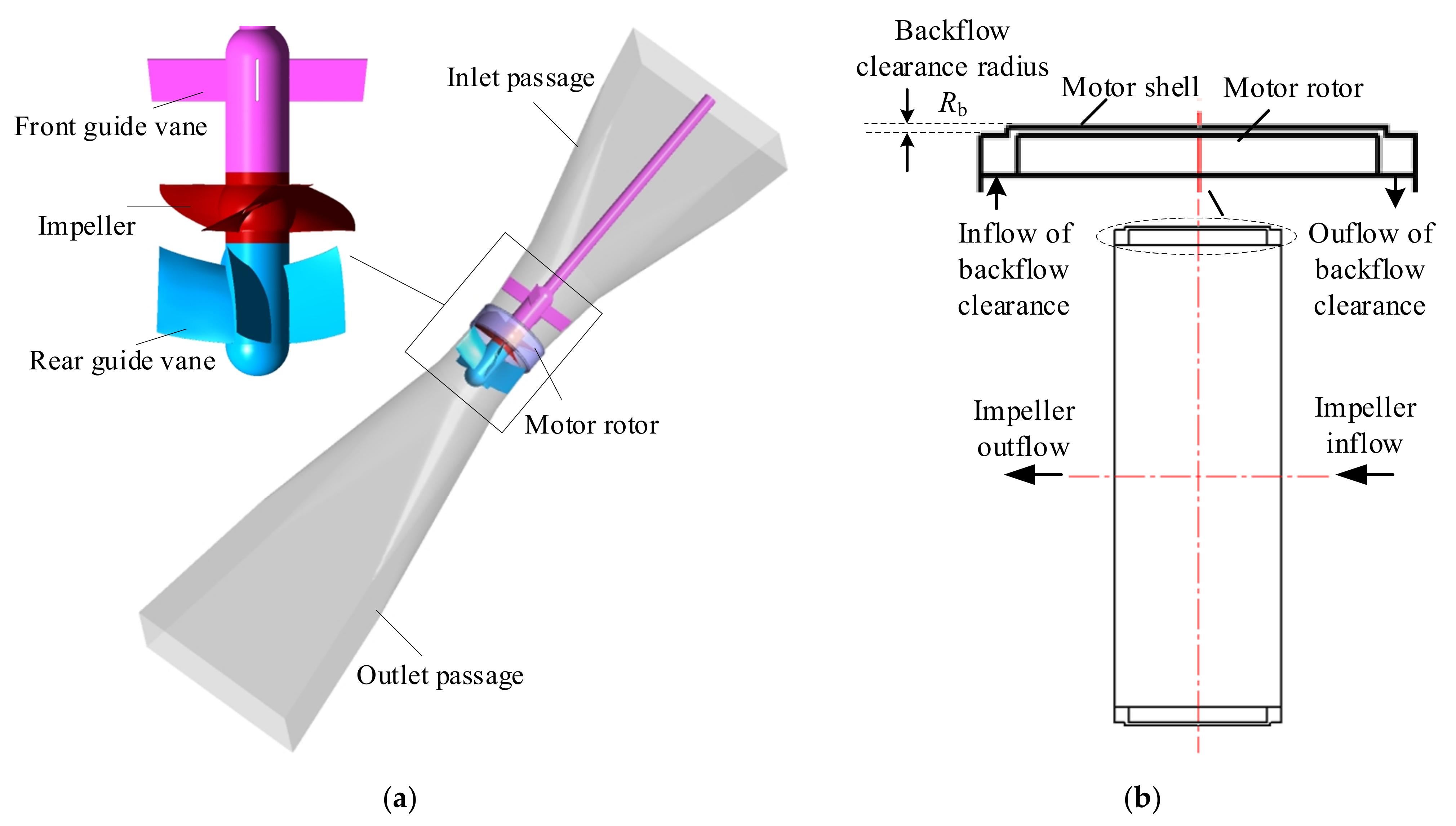

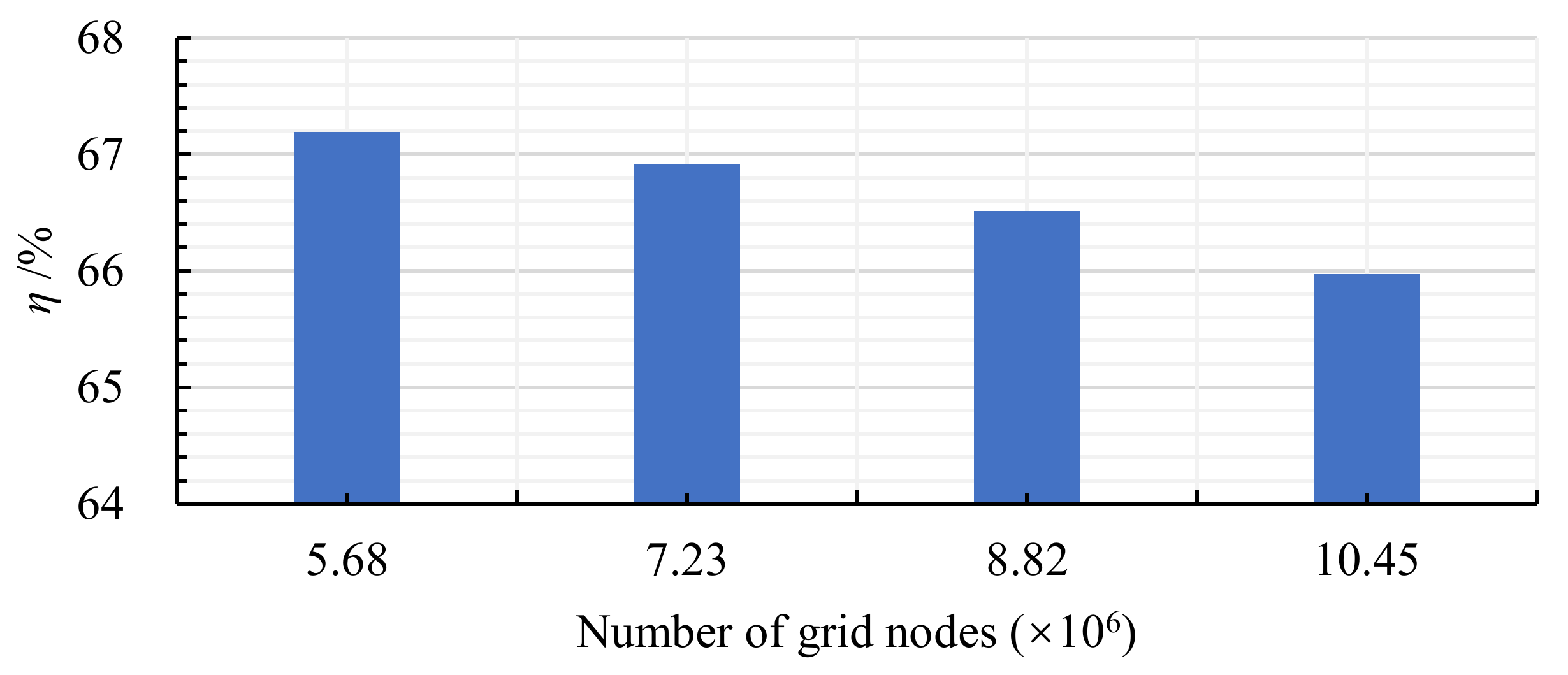

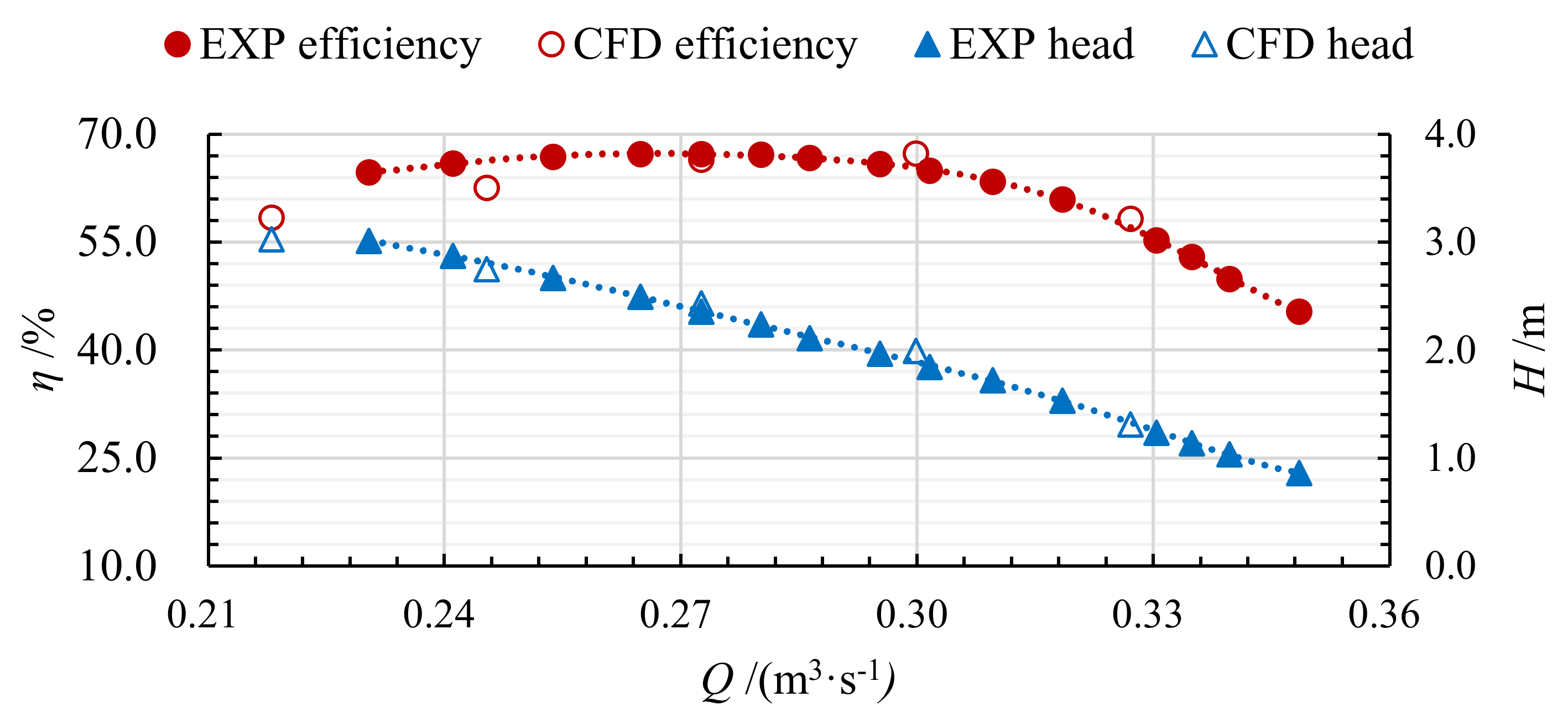

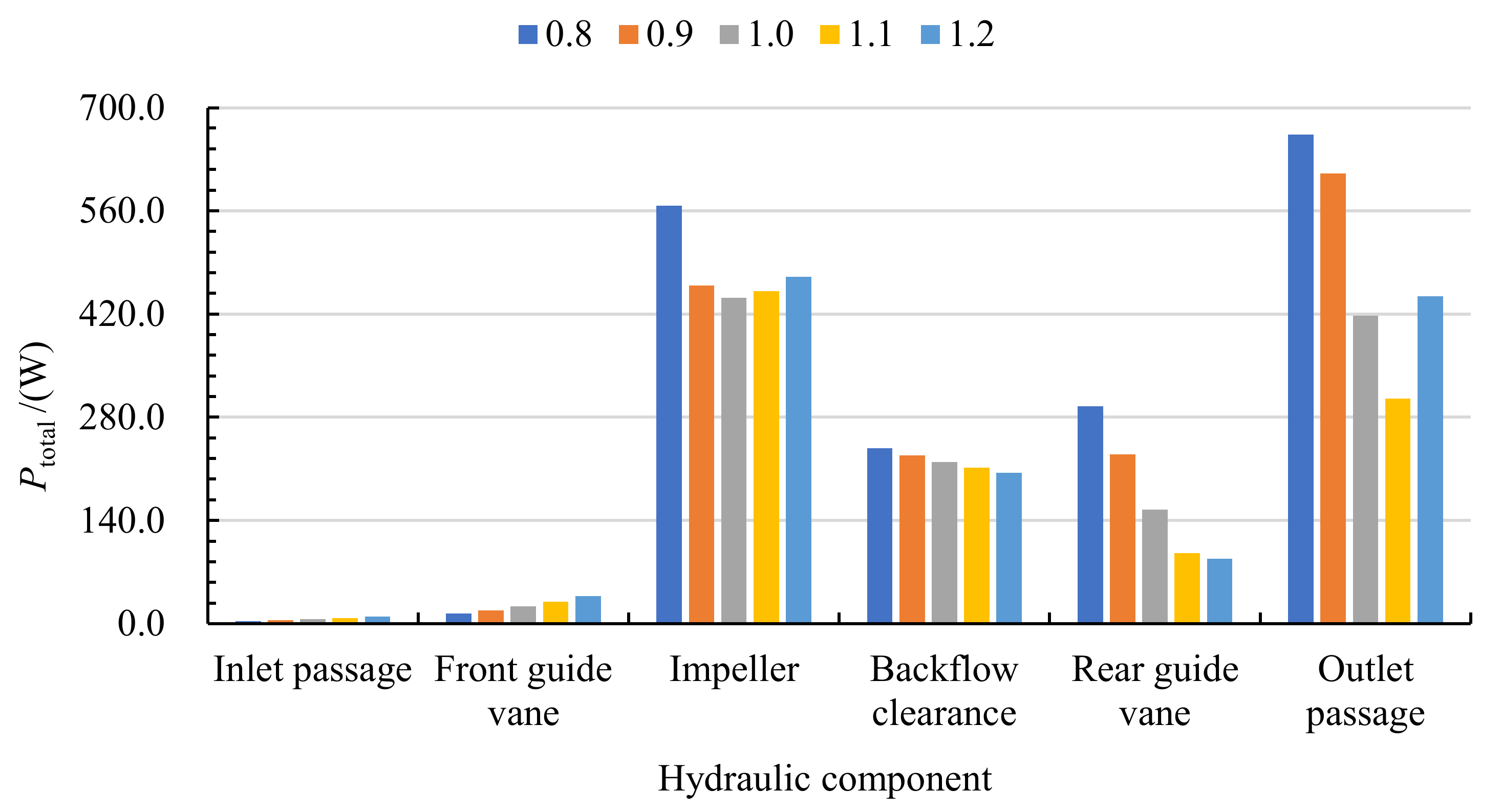


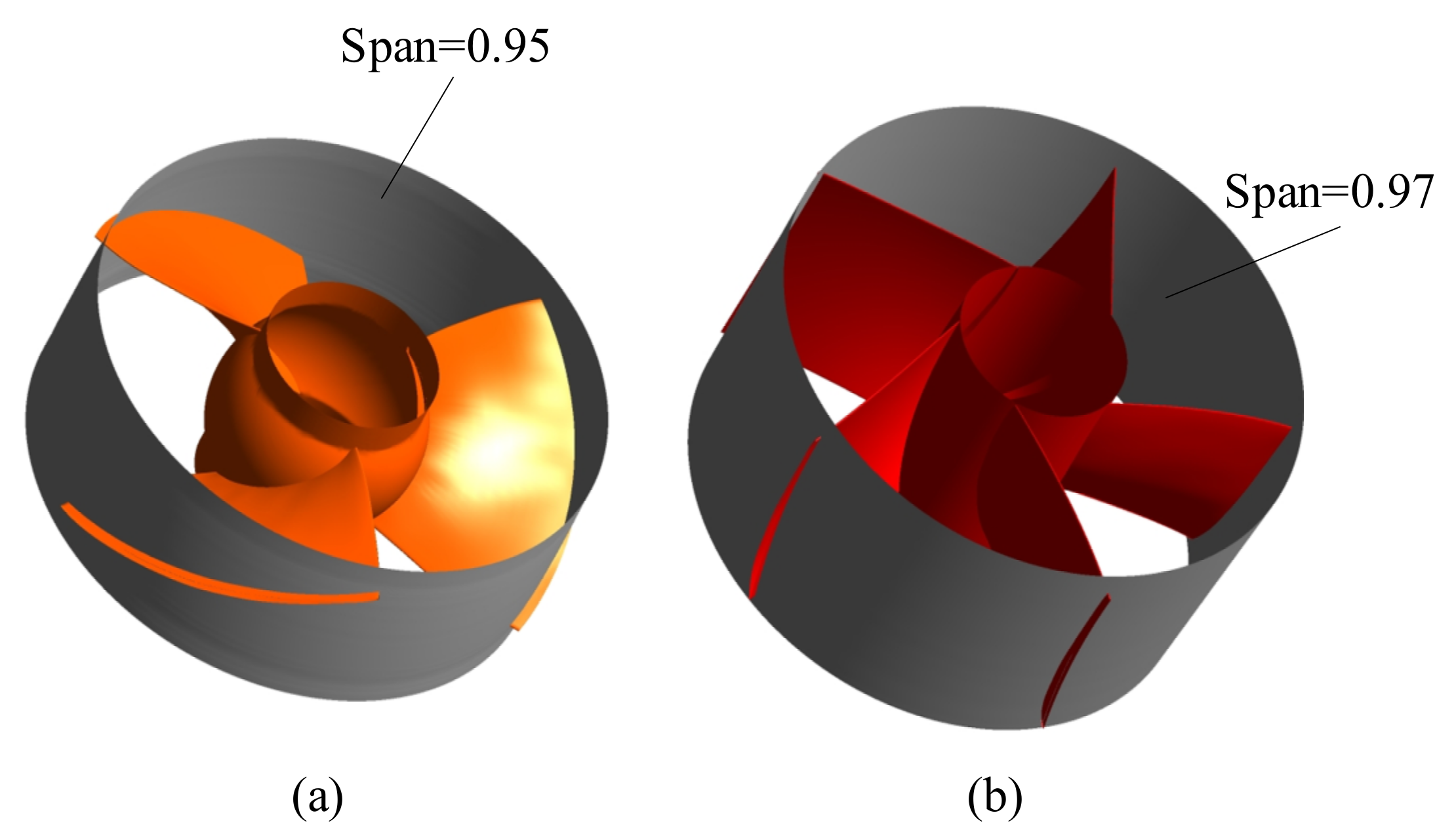
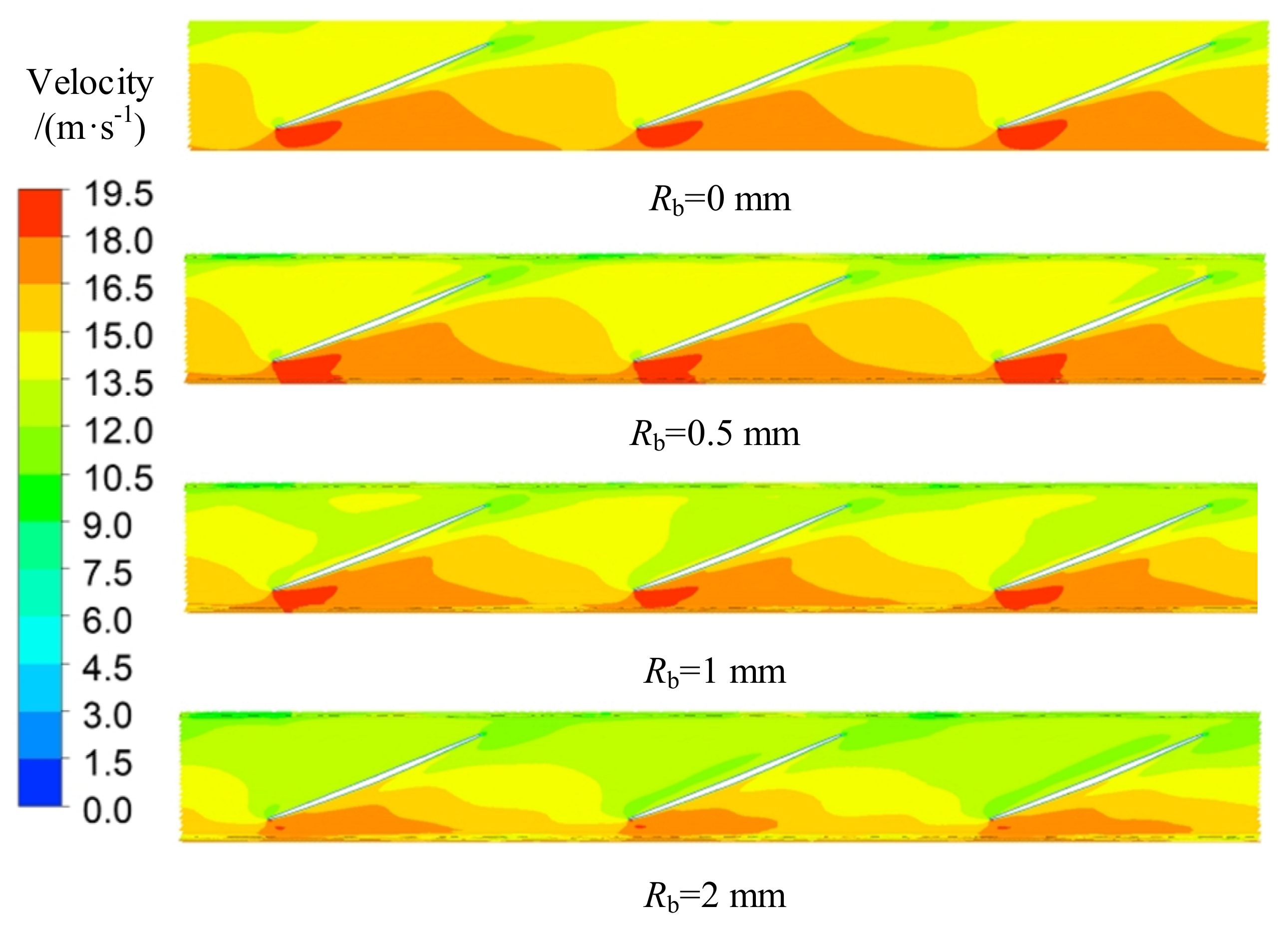
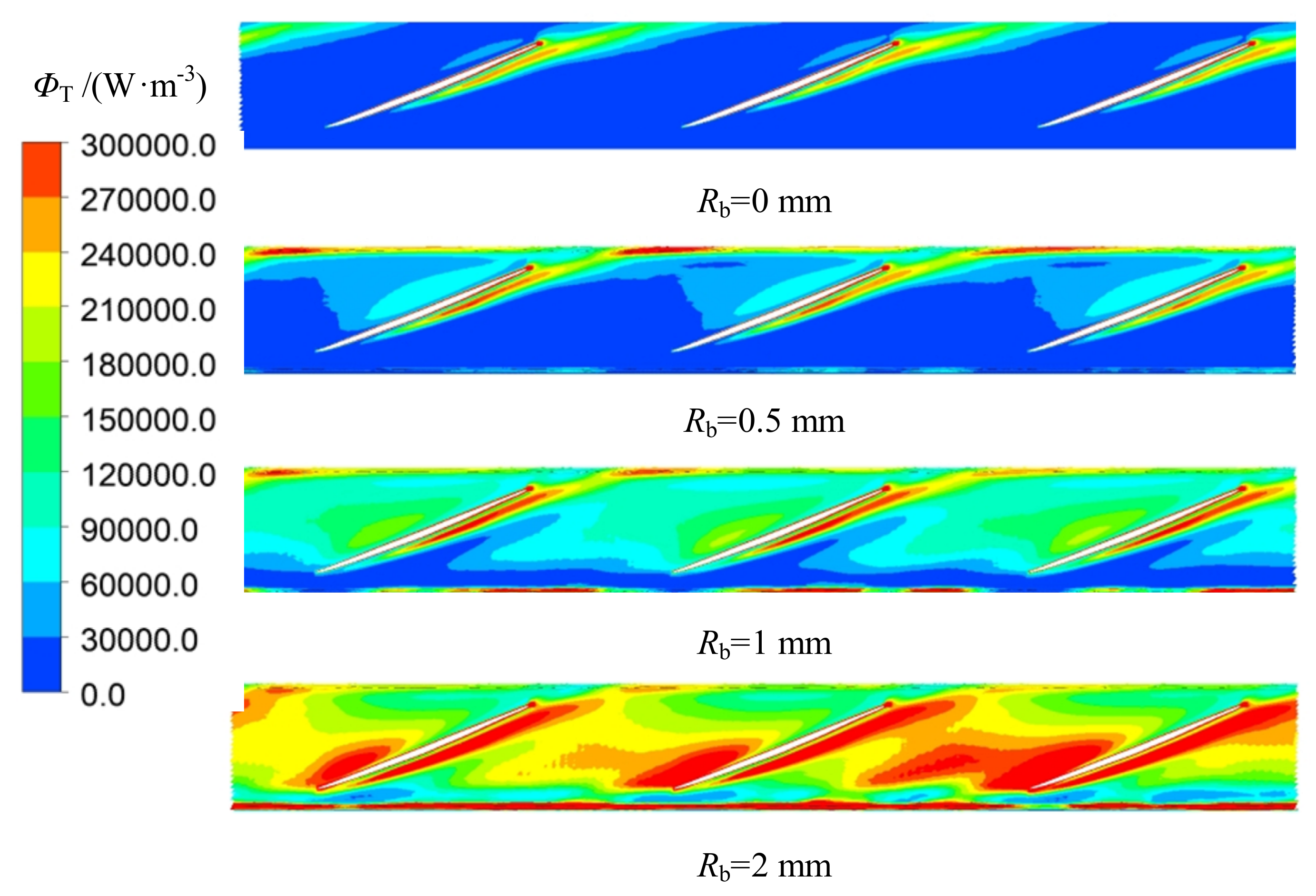
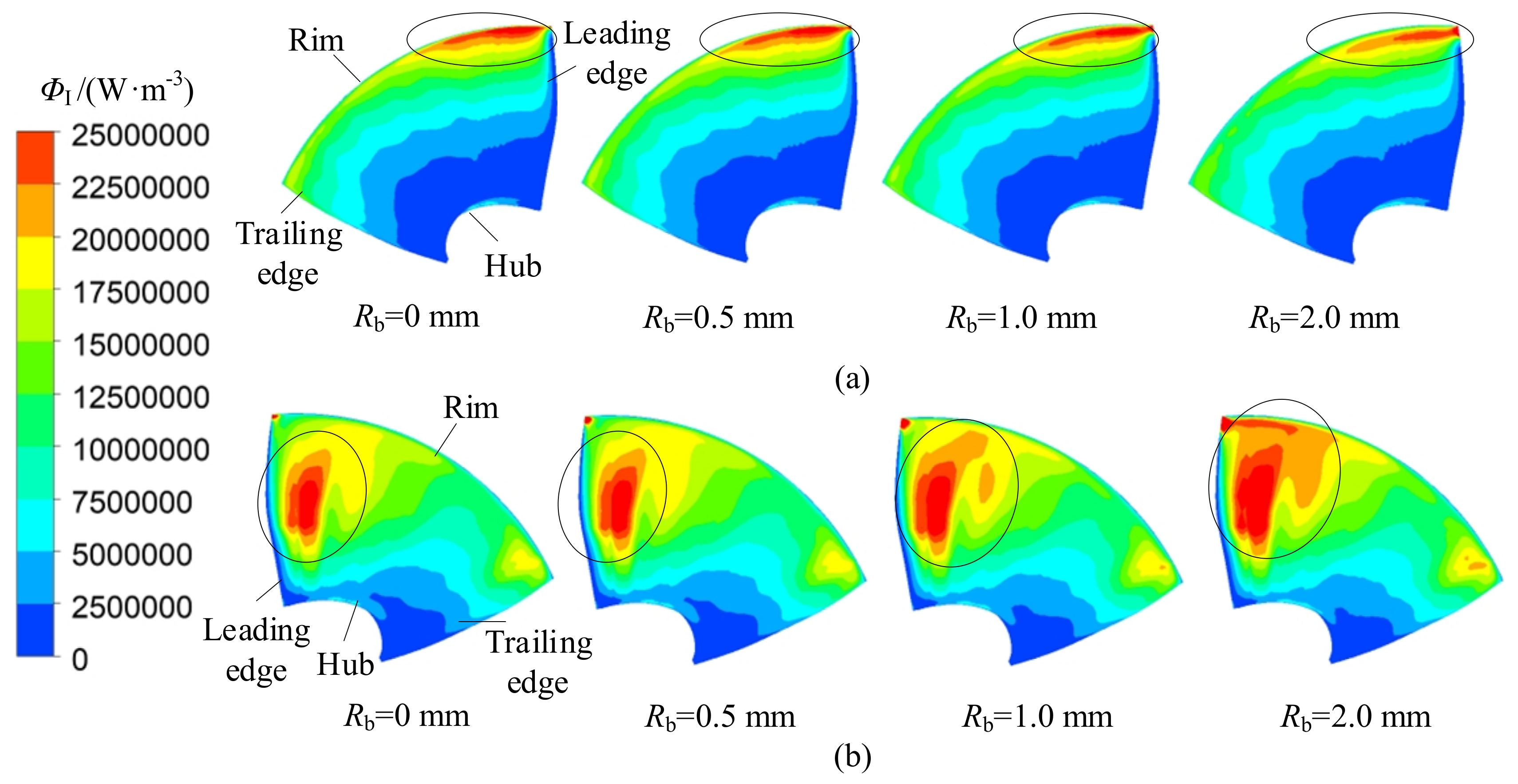

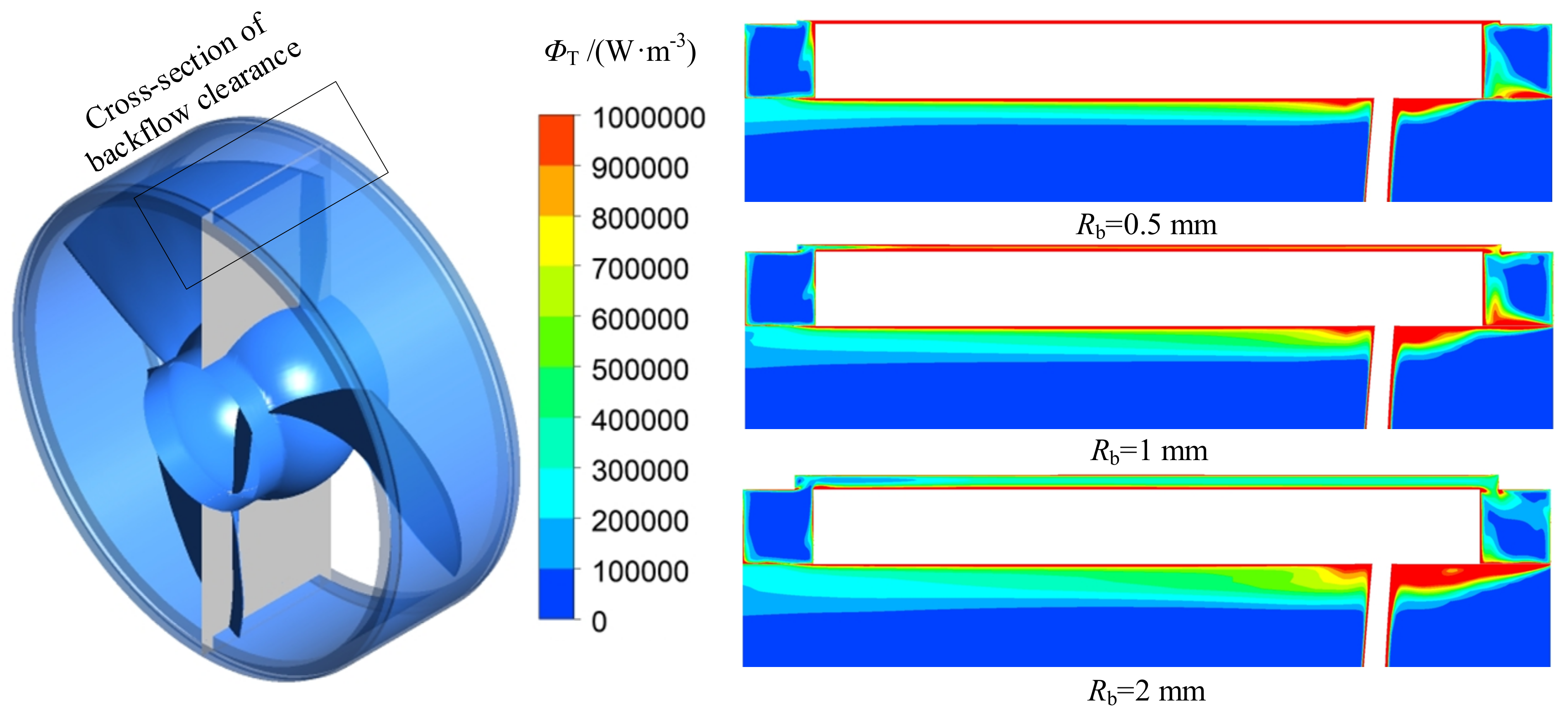
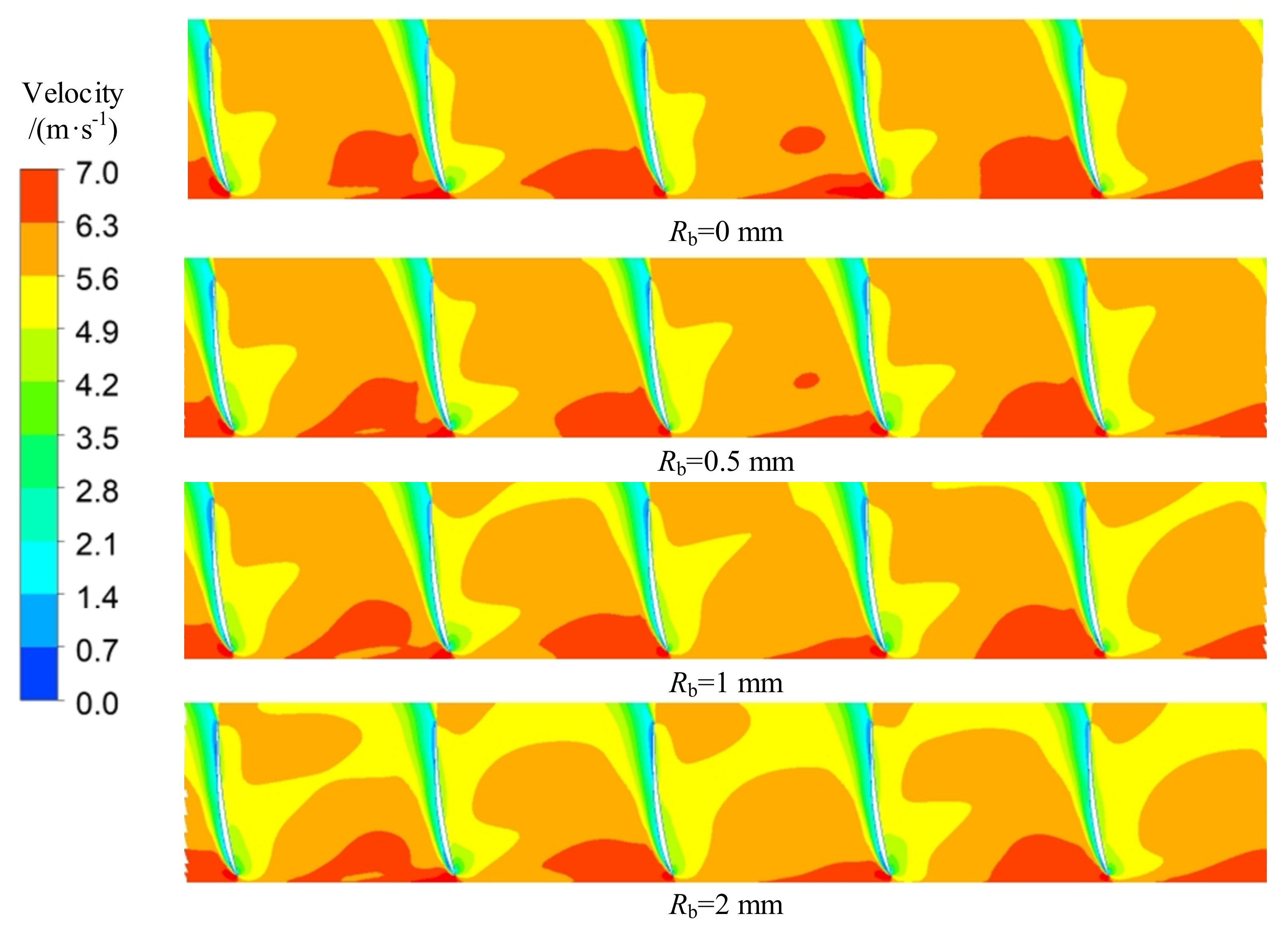
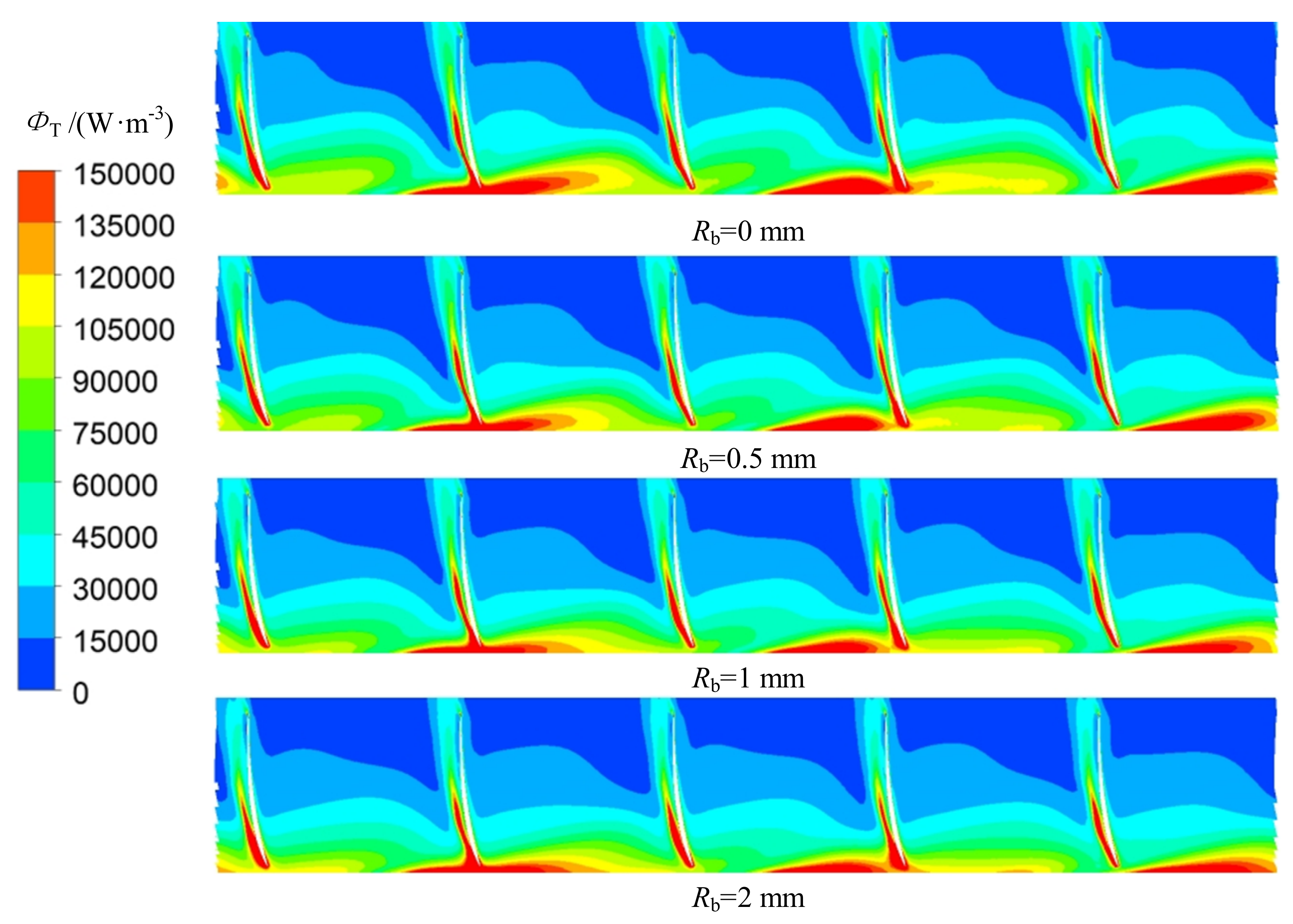

| Parameter | Unit | Value |
|---|---|---|
| Design parameters (experimental data) | ||
| Design flow rate Qdes | m3/s | 0.2726 |
| Design head Hdes | m | 2.36 |
| Design efficiency ηdes | % | 67.28 |
| Rotation speed | r/min | 1087.5 |
| Specific speed | - | 1088 |
| Geometry parameters | ||
| Blade number of front guide vane | - | 4 |
| Blade number of impeller | - | 3 |
| Impeller diameter | mm | 300 |
| Backflow clearance radius | mm | 0/0.5/1/2 |
| Blade number of rear guide vane | - | 5 |
Publisher’s Note: MDPI stays neutral with regard to jurisdictional claims in published maps and institutional affiliations. |
© 2021 by the authors. Licensee MDPI, Basel, Switzerland. This article is an open access article distributed under the terms and conditions of the Creative Commons Attribution (CC BY) license (https://creativecommons.org/licenses/by/4.0/).
Share and Cite
Meng, F.; Li, Y.; Pei, J. Energy Characteristics of Full Tubular Pump Device with Different Backflow Clearances Based on Entropy Production. Appl. Sci. 2021, 11, 3376. https://doi.org/10.3390/app11083376
Meng F, Li Y, Pei J. Energy Characteristics of Full Tubular Pump Device with Different Backflow Clearances Based on Entropy Production. Applied Sciences. 2021; 11(8):3376. https://doi.org/10.3390/app11083376
Chicago/Turabian StyleMeng, Fan, Yanjun Li, and Ji Pei. 2021. "Energy Characteristics of Full Tubular Pump Device with Different Backflow Clearances Based on Entropy Production" Applied Sciences 11, no. 8: 3376. https://doi.org/10.3390/app11083376
APA StyleMeng, F., Li, Y., & Pei, J. (2021). Energy Characteristics of Full Tubular Pump Device with Different Backflow Clearances Based on Entropy Production. Applied Sciences, 11(8), 3376. https://doi.org/10.3390/app11083376







